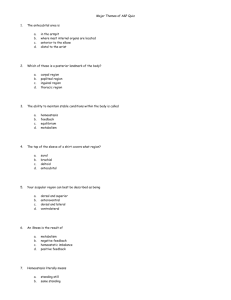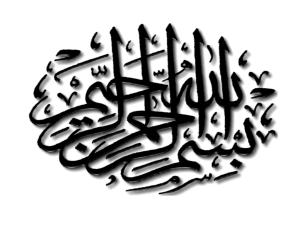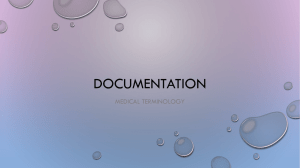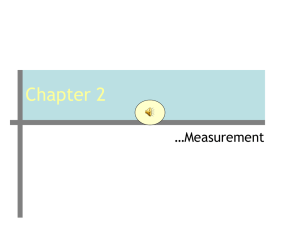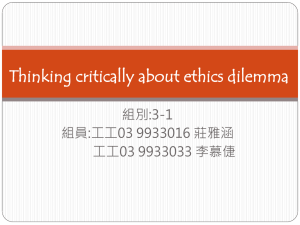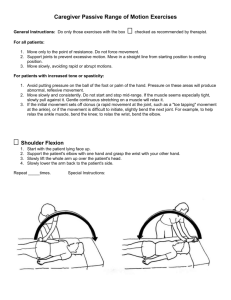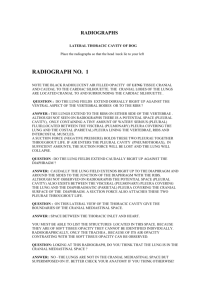Chapter 6
advertisement
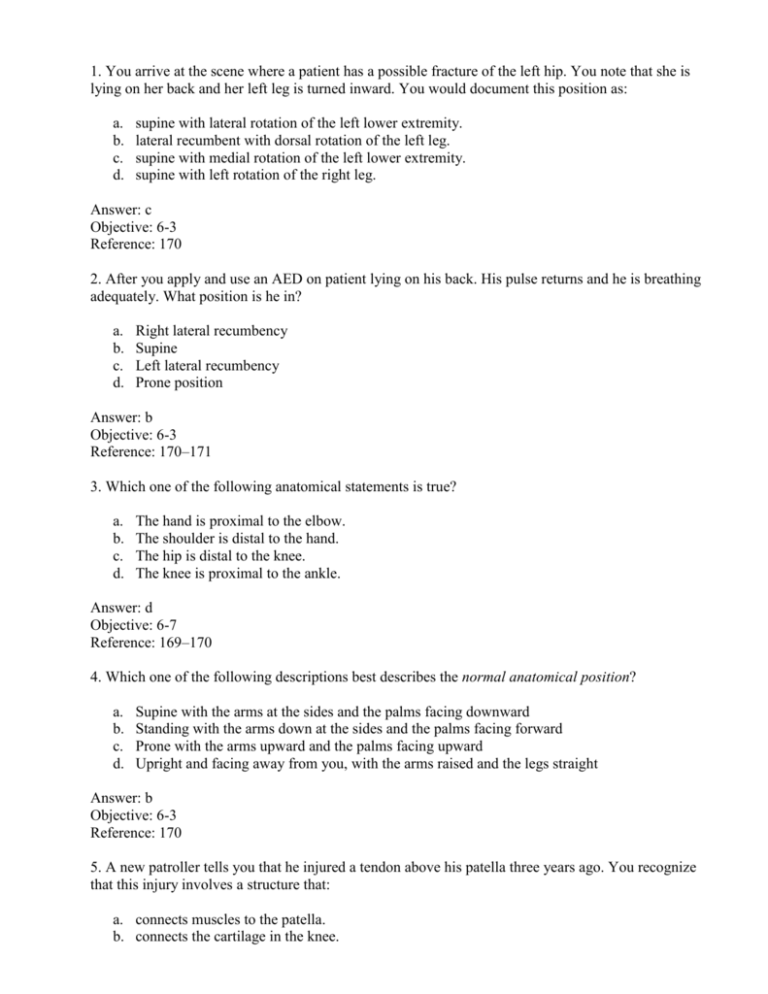
1. You arrive at the scene where a patient has a possible fracture of the left hip. You note that she is lying on her back and her left leg is turned inward. You would document this position as: a. b. c. d. supine with lateral rotation of the left lower extremity. lateral recumbent with dorsal rotation of the left leg. supine with medial rotation of the left lower extremity. supine with left rotation of the right leg. Answer: c Objective: 6-3 Reference: 170 2. After you apply and use an AED on patient lying on his back. His pulse returns and he is breathing adequately. What position is he in? a. b. c. d. Right lateral recumbency Supine Left lateral recumbency Prone position Answer: b Objective: 6-3 Reference: 170–171 3. Which one of the following anatomical statements is true? a. b. c. d. The hand is proximal to the elbow. The shoulder is distal to the hand. The hip is distal to the knee. The knee is proximal to the ankle. Answer: d Objective: 6-7 Reference: 169–170 4. Which one of the following descriptions best describes the normal anatomical position? a. b. c. d. Supine with the arms at the sides and the palms facing downward Standing with the arms down at the sides and the palms facing forward Prone with the arms upward and the palms facing upward Upright and facing away from you, with the arms raised and the legs straight Answer: b Objective: 6-3 Reference: 170 5. A new patroller tells you that he injured a tendon above his patella three years ago. You recognize that this injury involves a structure that: a. connects muscles to the patella. b. connects the cartilage in the knee. c. holds and secures the bones of the knee. d. attaches a ligament to the knee. Answer: a Objective: 6-5 Reference: 199 6. Involuntary or smooth muscles are found in which of the following structures? a. b. c. d. Muscles of the arms and legs Blood vessels and intestines The central nervous system The heart and blood vessels Answer: b Objective: 6-5 Reference: 199 7. A female patient suffers from a muscular disease and cannot walk. Based on the fact she cannot ambulate, you should recognize that which of the following muscle types is affected? a. b. c. d. Skeletal muscle Involuntary muscle Cardiac muscle Smooth muscle Answer: a Objective: 6-5 Reference: 199 8. Which of the following groups of bones could be involved in a patient with a “broken leg”? a. b. c. d. Acetabulum, calcaneous, carpals Femur, tibia, fibula Orbit, maxillae, mandible Radius, ulna, humerus Answer: b Objective: 6-5 Reference: 198 9. The lower jaw is also called the: a. b. c. d. mandible. zygoma. maxilla. mastoid. Answer: a Objective: 6-2 Reference: 198 10. The bones of the upper extremities include the: a. b. c. d. humerus and radius. humerus and calcaneous. phalanges and tibia. radius, ulna, and tarsals. Answer: a Objective: 6-2 Reference: 198 11. In which of the following respiratory structures would a blockage cause total cessation of air flow into and out of the lungs? a. b. c. d. The right bronchus The nasopharynx The trachea The esophagus Answer: c Objective: 6-5 Reference: 174 12. Which of the following functions is a function of the respiratory system? a. b. c. d. Transporting oxygen throughout the body Providing nutrients to cells Releasing oxygen from the body Providing the body oxygen Answer: d Objective: 6-5 Reference: 174 13. The structure containing the vocal cords is the: a. b. c. d. pharynx. larynx. trachea. sternum. Answer: b Objective: 6-2 Reference: 174 14. The leaf-shaped flap that helps prevent food from entering the lower respiratory system is called: a. the epiglottis. b. the trachea. c. the pharynx. d. a bronchiole. Answer: a Objective: 6-2 Reference: 174 15. Which one of the following lists represents a correct sequence for the passage of air into the lungs? a. b. c. d. Nose, bronchi, larynx, trachea, pharynx Larynx, esophagus, trachea, bronchi, alveoli Epiglottis, trachea, cricoid, bronchi, alveoli Mouth, pharynx, trachea, bronchi, alveoli Answer: d Objective: 6-5 Reference: 174 16. When the diaphragm and intercostal muscles relax, which one of the following occurs? a. b. c. d. Inhalation Release Inspiration Exhalation Answer: d Objective: 6-5 Reference: 177 17. Which one of the following events causes an individual to take a breath? a. b. c. d. The intercostal muscles relax. The chest cavity decreases in size. The diaphragm contracts. Pressure in the chest increases. Answer: c Objective: 6-5 Reference: 175 18. The primary function of the heart is: a. b. c. d. transferring oxygen to the cells. pumping blood throughout the body. oxygenating blood in the lungs. maintaining the volume of blood. Answer: b Objective: 6-5 Reference: 176 19. Which chamber of the heart is responsible for pumping blood to the lungs? a. b. c. d. The left atrium The left ventricle The right ventricle The right atrium Answer: c Objective: 6-5 Reference: 177 20. The left atrium: a. b. c. d. receives blood from the veins of the body. receives blood from the pulmonary veins. pumps blood to the lungs. pumps blood to the body. Answer: b Objective: 6-5 Reference: 177 21. Which of the following structures brings oxygen-depleted blood to the right atrium? a. b. c. d. The right ventricle The pulmonary artery The vena cavae The aorta Answer: c Objective: 6-5 Reference: 177 22. Following chemotherapy, a patient has a low white count. For which of the following is he at risk? a. b. c. d. Infection Bleeding High blood pressure Seizures Answer: a Objective: 6-5 Reference: 181 23. The fluid that carries blood cells and nutrients is: a. b. c. d. platelet fluid. hemoglobin. plasma. lymph. Answer: c Objective: 6-5 Reference: 181 24. The pressure exerted on the inside walls of arteries when the left ventricle contracts is called: a. b. c. d. systolic pressure. arterial pressure. diastolic pressure. residual pressure. Answer: a Objective: 6-5 Reference: 181 25. The nervous system is subdivided into which two main parts? a. b. c. d. The brain and spinal cord The involuntary and voluntary muscular systems The brain and extremity nerves The central and peripheral nerves Answer: d Objective: 6-5 Reference: 183 26. The terms occipital, frontal, and parietal refer to what part of the body? a. b. c. d. The chest The cranium The pelvis The spine Answer: b Objective: 6-2 Reference: 198 27. A patient has suffered damage to his brainstem. As a result of this injury which of the following signs might you expect to see? a. b. c. d. Sweating Abnormal respirations Pinpoint pupils Muscle spasms Answer: b Objective: 6-5 Reference: 183 28. What body system provides support and structure to the body? a. The endocrine system b. The nervous system c. The skeletal system d. The exocrine system Answer: c Objective: 6-5 Reference: 195 29. Which of the following lists identifies the regions of the spinal column from superior to inferior? a. b. c. d. Cervical, lumbar, thoracic, sacral, and coccyx Coccyx, lumbar, thoracic, cervical, and sacral Thoracic, lumbar, cervical, coccyx, and sacral Cervical, thoracic, lumbar, sacral, and coccyx Answer: d Objective: 6-5 Reference: 198 30. In a healthy heart, the electrical impulse that initiates contraction of the cardiac muscle originates in the: a. b. c. d. right atrium. left atrium. ventricles. interventricular septum. Answer: a Objective: 6-5 Reference: 177 31. As a patient gives her medical history to you, which of the following would you relate to the endocrine system? a. b. c. d. Removal of the gallbladder Failure of the kidneys Removal of the thyroid Heart failure Answer: c Objective: 6-5 Reference: 191 32. The thyroid glands, adrenal glands, pituitary glands, and gonads are part of the: a. b. c. d. nervous system. endocrine system. hormonal system. respiratory system. Answer: b Objective: 6-5 Reference: 191 33. A patient has suffered a burn to the skin. Based on the functions of the skin, to which of the following conditions is the patient most susceptible? a. b. c. d. Infection Fluid overload Heart problems Endocrine disorders Answer: a Objective: 6-5 Reference: 195 34. Which of the following functions is a function of the skeletal system? a. b. c. d. Producing blood cells Securing the abdominal organs in place Providing structure to blood vessels Forming the vital organs of the body Answer: a Objective: 6-5 Reference: 199 35. A patient experiencing thoracic spine pain has pain in his: a. b. c. d. neck. lower back. upper back. tailbone. Answer: c Objective: 6-2 Reference: 198 36. You are called to the lodge for a patient who has fallen. The report indicates the patient has a hematoma in the occipital area of her head. Based on this description, you should expect to find the injury in which area of the head? a. b. c. d. The top The side The back The front Answer: c Objective: 6-2 Reference: 198 37. A patellar fracture affects which part of the body? a. b. c. d. The tibia The hip The elbow The knee Answer: d Objective: 6-2 Reference: 198 38. Which of the following statements regarding the integumentary system is true? a. b. c. d. The skin protects the body against bacteria and other pathogens. The skin contains four layers: the epidermal, dermal, subcutaneous, and nerve layers. The epidermis is the thickest and most important layer of the skin. The dermal layer is the outermost layer of the skin and contains sensory nerves. Answer: a Objective: 6-5 Reference: 195 39. Under normal circumstances, carbon dioxide is excreted from the body by what structure? a. b. c. d. The kidney The urinary tract The lungs The hepatic vein Answer: c Objective: 6-5 Reference: 175 40. Which one of the following stimuli is the primary stimulus to breathe in normal human beings? a. b. c. d. The level of CO2 in the body The amount of oxygen the body requires The level of oxygen in the body The amount of nitrogen in the air Answer: a Objective: 6-5 Reference: 176 41. The study of human and animal structures at the gross and microscopic levels is known as: a. b. c. d. physiology. homeostasis. biology. anatomy. Answer: d Objective: 6-1 Reference: 168 42. Which of the following systems is not a body system? a. b. c. d. The endocrine system The thoracic system The skeletal system The respiratory system Answer: b Objective: 6-1 Reference: 174 43. The diaphragm separates the thoracic cavity from the: a. b. c. d. pelvic cavity. spinal cavity. abdominal cavity. heart. Answer: c Objective: 6-4 Reference: 171 44. The term used to describe the action of taking an extremity away from the midline of the body is: a. b. c. d. abduction. flexion. adduction. extension. Answer: a Objective: 6-2 Reference: 170 45. The wrist is: a. b. c. d. proximal to the elbow. external to the elbow. distal to the elbow. medial to the elbow. Answer: c Objective: 6-2 Reference: 170 46. The pelvic cavity contains which of the following organs? a. The bladder and the kidneys b. The kidneys and the spleen c. The pancreas and the bladder d. The rectum and the reproductive organs Answer: d Objective: 6-4 Reference: 171 47. A man lying in the prone position is: a. b. c. d. sitting with his legs slightly bent. lying face down on his stomach. lying face up on his back. lying on his back with his legs elevated higher than his head. Answer: b Objective: 6-3 Reference: 170 48. The basic unit of all living things is: a. b. c. d. the cell. an organ. a hormone. plasma. Answer: a Objective: 6-1 Reference: 174 49. The study of mechanical, physical, and biochemical functions of humans is known as: a. b. c. d. endocrinology. biology. anatomy. physiology. Answer: d Objective: 6-1 Reference: 168 50. A function of the lymphatic system is to: a. b. c. d. break down food. return interstitial fluid to the blood. control organ systems via hormones. move blood containing nutrients. Answer: b Objective: 6-5 Reference: 206 51. In humans, the body systems interact with each other to maintain a stable internal environment. An example of this is the nervous system, which works with the cardiovascular system to maintain a steady blood pressure. The ability of an organism to adjust its physiologic processes to maintain a relatively stable internal environment is known as: a. b. c. d. homeostasis. electrophysiology. metabolism. dependency. Answer: a Objective: 6-1 Reference: 206 52. The spleen is part of which body system? a. b. c. d. The cardiovascular system The endocrine system The gastrointestinal system The lymphatic system Answer: d Objective: 6-5 Reference: 206 53. Of the following responses, the best answer to the question, “What is a tissue?” is: a. b. c. d. “a collection of cells acting together to perform a specific function in the body.” “the basic unit of all living things.” “a structure that removes extra fluid from cells.” “the site where minerals are stored and blood cells are made.” Answer: a Objective: 6-1 Reference: 174 54. After examining his patient, your partner tells you that he believes the patient has hyperflexed the knee. What has happened if a patient has hyperflexed a knee? a. b. c. d. The patient has straightened the knee beyond its normal range of movement. The patient has bent the knee backward beyond its normal range of movement. The patient has pushed the kneecap too far to the right or left. The patient has straightened the knee into a normal position. Answer: b Objective: 6-7 Reference: 170 55. You arrive at an accident scene and find a patient lying on the ground with her right arm straight out to the side (at a 90-degree angle to her body). You ask her if she is able to pull the arm toward her body, but she cannot. You would document this as an inability to __________ her right arm. a. b. c. d. adduct abduct hyperflex hyperextend Answer: a Objective: 6-7 Reference: 170 56. You are assisting in the care of an elderly patient complaining of shortness of breath. You place the patient on 15L of oxygen via a nonrebreather mask and place him in a high Fowler’s position. This means that you will place this patient on his: a. b. c. d. left side, with his left arm over his head. back, with his upper body elevated at 90o from the waist. back, with his head down and his legs elevated higher than the head. back, with his upper body elevated at 45o from the waist. Answer: b Objective: 6-3 Reference: 171
